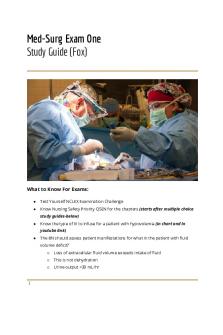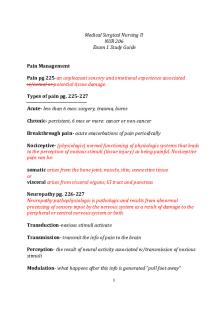Med Surg Exam 2 Rev - exam study guide and Hesi study guide for med surg PDF

| Title | Med Surg Exam 2 Rev - exam study guide and Hesi study guide for med surg |
|---|---|
| Author | Kerry Morales |
| Course | Medical Surgical nursing |
| Institution | Houston Community College |
| Pages | 17 |
| File Size | 1.3 MB |
| File Type | |
| Total Downloads | 31 |
| Total Views | 173 |
Summary
exam study guide and Hesi study guide for med surg...
Description
Med. Surg. Exam 2 Review **Blue text is everything Pref. Wooten discussed in lecture** What would be the responsibility of the nurse when caring for these patients? Chapter 17: Fluid, Electrolyte, and Acid-Base Imbalances (p.285) Electrolyte imbalances (p.286) Hypovolemia- Fluid volume deficit Hypervolemia- Fluid volume excess -High BP, edema or swelling, result of kidney failure
Sodium: 135-145mEq/L The Major electrolyte outside the cell; key role in BRAIN function (p.293) Hypernatremia: Water shifts out of the cell into ECF causing dehydration and shrinkage of cells Dehydration of brain cells results in neurologic manifestations such as intense thirst, agitation, and decreased alertness, ranging from sleepiness to coma
**↓↓Know Clinical Manifestations↓↓**
Hyponatremia: Water shifts into the brain cells causing irritability, headache, confusion, seizures, and even coma
Potassium: 3.5-5 mEq/L
The major electrolyte within the cell; key role in HEART function; Can cause dysrhythmia!! (p.296) Hyperkalemia: >5.0 mEq/L Increased concentration of potassium outside the cell S/S: Cramping leg pain or weakness, paralysis of other skeletal muscles, including respiratory muscles, abdominal cramping, diarrhea, irritability, anxiety, irregular pulse, hyperactivity of smooth muscles, disturbances in cardiac conduction, cardiac arrest Nursing Implementation: Diuretics, dialysis (6.5-7) and Kayexalate (may be given orally or as an enema) Hypokalemia: 10.2mg/dL Lethargy, weakness, depressed reflexes, decreased memory, confusion, personality changes, psychosis, anorexia, nausea, vomiting, bone pain, fractures, polyuria, dehydration, nephrolithiasis, stupor and coma. Hypocalcemia: 2.5 mEq/L Depresses neuromuscular and CNS functions S/S: Lethargy, drowsiness, flushed, warm skin, ↓ pulse, ↓ BP, nausea, vomiting, loss of deep tendon reflexes, muscle weakness, dysphagia, respiratory and cardiac arrest Hypomagnesemia: 60y Etiology and Patho: Retinal aging, genetics, family history Risk factors: Long-term exposure to UV light, hyperopia, cigarette smoking & light-colored eyes
Clinical Manifestations: Blurred & darkened vision, Scotomas (blind spots in the visual field) & metamorphopsia (distortion of vision) Collaborative Care: Nutrition: Dark green, leafy veggies containing lutein, vitamin C, vitamin E, beta-carotene, & zinc Drug therapy: Several medications injected directly into the vitreous cavity every 4-6 wks Glaucoma (p.398) Group of disorders characterized by increased IOP (normal is 10-21 mm Hg) & the consequences of elevated pressure, optic nerve atrophy, and peripheral visual field loss Clinical Manifestations: Develops slowly and w/out symptoms; eventually experiences tunnel vision Acute angle closure glaucoma: Ocular emergency, requires immediate intervention!! S/S: Sudden excruciating pain in or around the eye, nausea & vomiting, seeing halos around light, blurred vision and ocular redness; IOP > 50mm Hg Treatment: Miotics & oral or IV hyperosmotic agents: glycerin liquid (Ophthalgan), isosorbide solution (Ismotic), & mannitol solution (Osmitrol) for immediately lowering IOP Laser peripheral iridotomy or surgical iridectomy for long-term treatment Collaborative therapy: Topical cholinergic agent, hyperosmotic agent, laser peripheral iridotomy, surgical iridectomy Otosclerosis (p.405) Hereditary autosomal dominant disease; Most common cause of hearing loss in young adults Surgery: Stapedectomy or stapes prosthesis
Maniere’s disease: Inner ear disease (p.405) Clinical Manifestations: Tinnitus, fluctuating sensorineural hearing loss, and aural fullness, sudden, severe attacks of vertigo w/ nausea, vomiting, sweating & pallor Drug therapy: Sedatives, benzodiazepines, anticholinergics, antihistamines, antiemetics Nursing Management: Avoid sudden head movements, fluorescent/ flickering lights, keep a basin close by for vomiting, risk for fall: side rails up, bed in lowest position, Monitor input & output Surgical therapy: Endolymphatic sac decompression, endolymphatic shunt, vestibular nerve suction, labyrinthectomy Chapter 41: Obesity (p.906) 35% of adults in the US are obese Etiology & Patho: -Primary obesity: Excess caloric intake
-Secondary obesity: Congenital anomalies, chromosomal anomalies, metabolic problems or CNS disorders & lesions Classification: -Waist Circumference -WHR Waist-to-hip ratio -Body shape -BMI Body Mass Index: BMI 40 Class 3 Severely Obese Treatment Nutritional therapy/ Diet: -Dietary reduction of 500-1000 cal/day for a loss of 1-2 lb/wk -Supervised diet of 800 or less cal/day may be prescribed but not on a long term basis -Adequate fruits and veggies to meet daily Vit A & C requirements, Lean meat, fish & eggs for protein and B-complex Vit.; ⅔ plan-source foods ⅓ animal protein -Fad diets/low carb diets NOT recommended; rapid weight loss but hard to maintain long term -Plateaus are normal; monitor progress by checking weight wkly (not daily) Exercise: -30 min to an hr/day -Lowers rates of morbidity and mortality -Psychological benefits: ↓ stress, better-quality sleep, ↑ stamina & energy levels, improves self-esteem & mood
*Benefits of weight management*
Behavior modification: 1) Self-monitoring: Record type & time food was consumed 2) Stimulus control: Separate events that trigger eating from the act of eating 3) Rewards: Incentives for weight loss; should be long term and short term Support groups: Weight watcher, Take Off Pounds Sensibly (TOPS), Commercial weight reduction centers include nutrition education and behavior modification; Workplace Weight loss programs Drug therapy: Appetite suppressing drugs, Nutrient absorption-blocking drugs (Orlistat), Serotonin agonist (Belviq), Phentermine and Topiramate (Qsymia) Surgical therapy (Bariatric surgery) Only treatment that’s been found successful and lasting impact for severe obesity Roux-en-Y Gastric Bypass: -Most common; considered the gold standard
-Outcomes: Improved glucose control with improvement or reversal of diabetes, normalization of BP, decreased total cholesterol and triglycerides, decreased GERD, and decreased sleep apnea
PreOperational Care: -Ensure that oversized cuff size, large gown and bed are available -Assess heart, lung & bowel sounds -Teach proper coughing & deep breathing techniques and methods of turning/ repositioning to prevent pulmonary complications after surgery -Teach use of spirometer to help prevent postOp lung congestion Post Op Care: -Immediately assess for cardiopulmonary complications, thrombus formation, anastomosis leaks and electrolyte imbalances -Maintain pts head at a 35-45 degree angle to reduce abd pressure and increase lung expansion -Turn pt; ambulate evening of surgery then 3-4xs daily; Active & passive ROM exercises daily Complications: -Co-morbidities & obesity increase the risk for complications! -Deep Vein Thrombosis (DVT) Order: Antiembolic/ sequential compression stockings w/ low-dose heparin (lovenox) to minimize the risk -Wound infection, dehiscence- use sterile wet dressing; assess pts skin, keep folds dry and clean to prevent infection
Chapter 42:Upper GI Problems (p.924) Hiatal Hernia (p.935) Herniation of part of the stomach into esophagus through opening (hiatus) in the diaphragm Clinical Manifestations: Usually asymptomatic but if s/s are present tits like having GERD
Complications: GERD, esophagitis, hemorrhage from erosion, stenosis (narrowing of the esophagus), ulcerations of the herniated portion of the stomach, strangulation of the hernia, and regurgitation with tracheal aspiration Nursing/Collaborative therapy: -Conservative therapy of hiatal hernia is similar to GERD -Teach pt not to wear tight clothing, avoid lifting and straining -Surgical therapy: herniotomy, herniorrhaphy, gastropexy Gerd (p.931) -Not a disease but a syndrome; Most common upper GI problem -Chronic symptom of mucosal damage caused by reflux of stomach acid into the lower esophagus -Persistence of mild symptoms (more than 2x/wk) or Moderate-Severe symptoms once a week Etiology: No one single cause, Gastric HCl acid & pepsin secretions that reflux & cause esophageal irritation and inflammation (esophagitis) Clinical Manifestations: Vary from person to person *Heartburn (pyrosis), Pain in the upper abd (Dyspepsia), Regurgitation, hypersalivation, disturbed sleep patterns, hoarseness, sore throat and chest pain; Resp. symptoms: wheezing, coughing & dyspnea Complications: -Esophagitis: Inflammation of the esophagus -Barrett’s esophagus (esophageal metaplasia): Precancerous lesion that increases pts risk for esophageal adenocarcinoma -Bronchospasm, laryngospasm, cricopharyngeal spasms Collaborative Care: -Lifestyle Modifications: Avoid factors that trigger symptoms, weight reduction and stop smoking -Nutritional Therapy: Avoid foods that decrease LES pressure (chocolate, peppermint, tomatoes, fatty foods, coffee, and tea) Use gum & oral lozenges to help w/ mild symptoms -Drug Therapy: Proton pump inhibitors (PPIs) and histamine (H2)-receptor blockers are common and effective; PPIs are more effective in healing esophagitis than H2-receptor blockers ** See table 42-10 below** Pt & caregiver teaching: low-fat diet, eat small, frequent meals, no alcohol, smoking or caffeine. Advise pt to not lie down 2-3 hr after eating, no tight clothing around the waist, or bending over, avoid eating 3hr before bedtime. Sleep w/ head of bed elevated on blocks. Educate drugs and their common side effect. Discuss ways to lose weight Peptic Ulcer disease PUD (p.942) **↓↓Know Clinical Manifestations↓↓**
Erosion of the GI mucosa from the digestive actions of HCl acid & pepsin Types: -Acute: Superficial erosion w/ minimal inflammation, short duration and resolves quickly when its cause is identified and removed. -Chronic: (more common) Eroding through the muscular wall with the formation of fibrous tissue, long duration Etiology: -Helicobacter pylori: ⅔ world population is infected w/ H.pylori -Medication Induced Injury: Ulcerogenic drugs (aspirin,NSAIDs) is responsible for the majority of non-H. pylori peptic ulcers -Lifestyle factors: High alcohol intake, smoking and caffeinated beverages -Gastric ulcers: Pain 1-2hrs after meals -Duodenal Ulcers: Pain 2-4hrs after meals -Stress Related Mucosal Disease (SRMD) Complications: -Hemorrhage: Most common -Perforation: Sudden severe upper abd. Pain, abd appears rigid & boardlike, ↑HR & Weak pulse Causes Peritonitis!! -Gastric outlet Obstruction Collaborative Care: -Drug therapy: -Nutritional therapy: Avoid caffeine, restrict alcohol & avoid spicy foods -Surgical therapy: Partial gastrectomy, vagotomy, and pyloroplasty -Preoperative Care: Instruct what to expect postOp, include comfort measures, pain relief, coughing and deep breathing exercises, use of NG tube & IV fluid administration -Postoperative Complications: Dumping syndrome, postprandial hypoglycemia & bile reflux gastritis -Postoperative Care: -Observe gastric aspirate for color, amount & odor (bright red→gradual darker→yellow/green) -Obs for signs of ↓peristalsis like abd distention & lower abd discomfort -Monitor input & output Q4h4 -Pain management -Turning; have pt hold pillow over incision while repositioning and performing deep breathing techniques
**Know the PPIs and Histamine-Receptor Blockers**
Chapter 43: Lower GI Problems (p.961) Constipation (p.966)
Etiology: -Insufficient dietary fiber or fluids, Decreased physical activity, Ignoring the urge to defecate, opioids -Disease: Diabetes mellitus, Parkinson’s disease & multiple sclerosis -Stress, anxiety and depression Clinical Manifestations: Abdominal distention, bloating, ↑ flatulence, ↑ rectal pressure Complications: Hemorrhoids, Colonic perforation (life threatening, causes abd. pain, nausea, vomiting, fever & ↑WBC count), Rectal mucosal ulcers and fissures, Diverticulosis Diagnostic studies: -Compare the current symptoms with the patient’s normal pattern of elimination -Abd. x-rays, barium enema, colonoscopy, sigmoidoscopy & anorectal manometry Nursing Management: Teach pt the importance of diet, Educate high fiber diet: fruits, veggies, grains, whole wheat, bran and prunes; Emphasize increasing fluid intake and exercising regularly, teach pt to establish regular time to defecate and no to suppress the urge, discourage laxatives and enemas, teach to place footstool in front of toilet, sit on commode w/ knees higher than the hips. If using bedpan elevate head of the bed as high as pt can tolerate, provide privacy Appendicitis (p.973) Inflammation of the appendix Etiology & Patho: Common cause is obstruction of the lumen by accumulated feces Clinical Manifestations: Periumbilical pain (sharp pain around your navel), acute abd. pain, anorexia, nausea & vomiting Pain = persistent & continuous as it shifts to RLQ & localizes at *McBurney’s point* (½ way btwn umbilicus & right iliac crest) Further assessment reveals localized tenderness, rebound tenderness & muscle guarding Coughing, sneezing & deep inhalation magnify the pain; may have low fever Diagnostic Studies and Collaborative Care Pt history, physical exam, differential WBC count, urinalysis, CT and ultrasound for diagnostic If diagnosis & treatment are delayed, appendix can rupture & resulting peritonitis can be fatal Treatment: Immediate surgical removal- Appendectomy, Antibiotics & fluid resuscitation are given before surgery Nursing Management/ pt teaching: Pt w/ abd. Pain should see health care provider & avoid self treatment, laxatives & enemas may cause perforation of appendix; keep pt NPO until seen by health care provider; Postop: ambulate day of or after surgery, diet is advanced as tolerated, d/c day 2 post op, resume normal activities 2-3 wks post op
Peritonitis: Primary & Secondary (p.974) Etiology & Patho:
Results from a localized or generalized inflammatory process of the peritoneum
Clinical Manifestations: Abd. pain, tenderness, muscular rigidity & spasm, rebound tenderness, Abd. distention, fever, tachycardia, tachypnea, nausea, vomiting & altered bowel habits Complications: Hypovolemic shock, sepsis, intraabdominal abscess formation, paralytic ileus & acute resp. distress syndrome Diverticulitis (p.994) Inflammation of the diverticula (small pouches of mucosa that develop in the colon), resulting in perforation into the peritoneum Etiology and Patho: -Commonly found in Left descending, sigmoid colon -Caused by high luminal pressures from not getting enough fiber Clinical Manifestations: -Typically asymptomatic -Abd. pain, bloating, flatulence, changes in bowel habits -Acute pain in LLQ, palpable abd. mass, fever Pt. teaching: Prevention: High fiber diet, decreased intake of fat and red meat & high levels of physical activity Nursing Management: -Weight reduction for obese pts -Teach pt to avoid factors that ↑ intra abd. pressure: straining, vomiting, bending, lifting, wearing tight clothing -If pt at home: Let colon rest and inflammation go down, oral antibiotics, clear liquid diet -Hospitalization: NPO, bed rest, fluids & IV antibiotics, Obs for signs of abscess, bleeding & peritonitis, monitor WBC count Inflammatory Bowel Disease (IBD) (p.975) -Autoimmune disease involving an immune reaction to a person’s own intestinal tract -Classified as either Crohn’s or Ulcerative colitis depending on the s/s
Etiology and Patho: Environmental factors (diet, hygiene, stress, smoking, NSAIDS), genetics, immune function, Complications: -Local/GI tract: hemorrhage, strictures, perforation (w/ possible peritonitis), fistulas & colonic dilation (toxic megacolon) -Systemic: joint, eye, mouth, kidney, bone, vascular, and skin problems Pt teaching: (1) Rest & diet management (2) Peri-anal care (3) Drug action & side effects (4) Symptoms of recurrence of disease (5) When to seek medical care (6) Diversional activities to reduce stress. Ulcerative Colitis (p.975) Disease of the colon & rectum Pattern of Inflammation: -Affects mucosal layer: Innermost layer of the bowel wall -Starts in rectum moves to the cecum -Fistulas & abscesses are rare Clinical Manifestation: Bloody diarrhea & abdominal pain (primary), bloody stools (common), weight loss, fever, and fatigue Complications: Colonic dilation (toxic megacolon) Surgical therapy: Laparoscopic procedures -Total proctocolectomy with ileal pouch/anal anastomosis: (most common) 2 surgery procedure -Total proctocolectomy with permanent ileostomy PostOp Care: Monitor peristomal skin integrity, Observe for signs of hemorrhage, abd. abscess, bowel obstruction and dehydration
Crohns’ Disease (p.975) Pattern of Inflammation: -Affects all layers of the bowel wall -Occurs anywhere in the GI tract (mouth to anus) but commonly terminal ileum -Skip lesions: Segments of normal bowel between diseased portions -Ulcerations are deep & longitudinal -Fistulas Clinical Manifestations: Diarrhea, crampy abd. pain & weight loss (common), bloody stools, fever, and fatigue Complications: - Inflammation goes through the entire wall, microscopic leaks allow for bowel contents to enter the peritoneal cavity and form abscesses or peritonitis. -Perineal abscess and fistulas (between bowel & bladder or between bowel & vagina) -C.Diff Nursing Management: Methotrexate- Monitor CBCs and liver enzymes; shouldn’t be taken for women who are pregnant
Chapter 46: Renal and Urologic problems (p.1064) Acute pyelonephritis (p.1065) -comes on all of a sudden -Inflammation caused by infection of renal parenchyma & collecting systems (including renal pelvis) -Upper urinary tract Etiology and Patho (p.1069) -Begins w/ colonization and infection of lower urinary tract via ascending urethral route -Bacteria found in the intestinal tract: E.coli or proteus, klebsiella or enterobacter -Preexisting factors: Vesicoureteral reflux(retrograde mvmnt of urine from lower to upper urinary tract) Or dysfunction of lower urinary tract (like an obstruction) -Commonly starts in renal medulla & spreads to adjacent cortex Clinical Manifestations: Sudden onset of chills, fever, Flank pain, fatigue, vomiting, malaise, dysuria, urgency and frequency Urinalysis results indicate pyuria, bacteriuria & hematuria (of varying degrees) Treatment: Depends on the severity of symptoms
Glomerulonephritis (p.1073) Can be acute or chronic Inflammation of the glomeruli, Affects both kidneys equally Acute poststreptococcal glomerulonephritis (APSGN): Common type of acute glomerulonephritis Common in children & young adults; develops 1-2 wk after streptococcal throat infection Clinical Manifestations: Generalized body edema, hypertension, oliguria, hematuria with a *smoky or rusty appearance*, proteinuria, fluid retention Nursing Management: Symptomatic relief: Rest, restrict fluid and sodium intake for edema, administer diuretics, measure intake and output, Check BP, restrict dietary protein intake for proteinuria, Antibiotics for streptococcal infection; Typically make a full recovery
Nephrotic Syndrome (p.1075) When glomerulus is excessively permeable to plasma protein, causing proteinuria that leads to low plasma albumin and tissue edema Clinical Manifestations: Peripheral edema, massive proteinuria, hypertension, hyperlipidemia & hypoalbuminemia Lab findings: ↓ serum albumin, ↓ total serum protein & ↑ serum cholesterol Ascites & anasarca (massive generalized edema) develop if there’s severe hypoalbuminemia Measure abdomen Nursing Management: Depends on the cause Focus on the management of edema -Angiotensin-converting enzyme inhibitors; nonsteroidal antiinflammatory drugs (NSAIDs); and a low-sodium, moderate-protein diet -Thiazide or loop diuretics -Daily weight -Measure pt input & output -Measure abdominal girth Clean the edematous skin carefully. Avoid trauma to the skin. Pt at risk for skin breakdown Teach to avoid exposure to persons with known infections Support coping with altered body image due to embarrassment/ shame from body edema Drug therapy: Corticosteroids and cyclophosphamide Prednisone Urinary tract Calculi (p.1076) Nephrolithiasis (kidney stone disease) Etiology and Patho: -Metabolic: ↑calcium, oxaluric acid, uric acid or citric acid in the urine -Climate: Heat causes ↑flu...
Similar Free PDFs
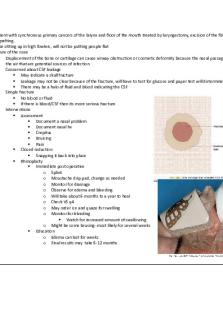
Med Surg II - Exam 2 Study Guide
- 57 Pages

Med Surg 2 Exam 3 Study Guide
- 22 Pages

Med surg exam 1 study guide
- 25 Pages
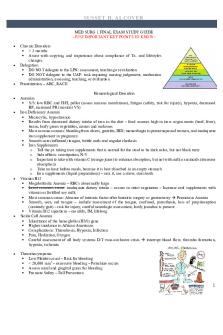
MED SURG 1 Final EXAM Study Guide
- 10 Pages

Med surg exam 3 study guide
- 68 Pages
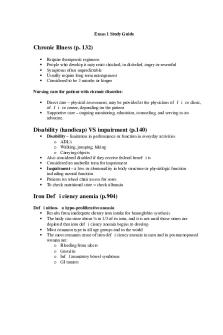
Exam 1 Study Guide - Med-Surg
- 26 Pages

Med Surg Study guide Notes
- 66 Pages

Med Surg 2 Final Study Guide
- 25 Pages

Med-Surg Test #2 Study Guide
- 10 Pages

Med Surg 2 Study Guide Answer Key
- 145 Pages
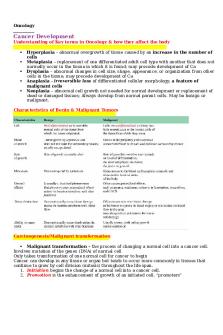
MED SURG 2 first study guide
- 20 Pages
Popular Institutions
- Tinajero National High School - Annex
- Politeknik Caltex Riau
- Yokohama City University
- SGT University
- University of Al-Qadisiyah
- Divine Word College of Vigan
- Techniek College Rotterdam
- Universidade de Santiago
- Universiti Teknologi MARA Cawangan Johor Kampus Pasir Gudang
- Poltekkes Kemenkes Yogyakarta
- Baguio City National High School
- Colegio san marcos
- preparatoria uno
- Centro de Bachillerato Tecnológico Industrial y de Servicios No. 107
- Dalian Maritime University
- Quang Trung Secondary School
- Colegio Tecnológico en Informática
- Corporación Regional de Educación Superior
- Grupo CEDVA
- Dar Al Uloom University
- Centro de Estudios Preuniversitarios de la Universidad Nacional de Ingeniería
- 上智大学
- Aakash International School, Nuna Majara
- San Felipe Neri Catholic School
- Kang Chiao International School - New Taipei City
- Misamis Occidental National High School
- Institución Educativa Escuela Normal Juan Ladrilleros
- Kolehiyo ng Pantukan
- Batanes State College
- Instituto Continental
- Sekolah Menengah Kejuruan Kesehatan Kaltara (Tarakan)
- Colegio de La Inmaculada Concepcion - Cebu

